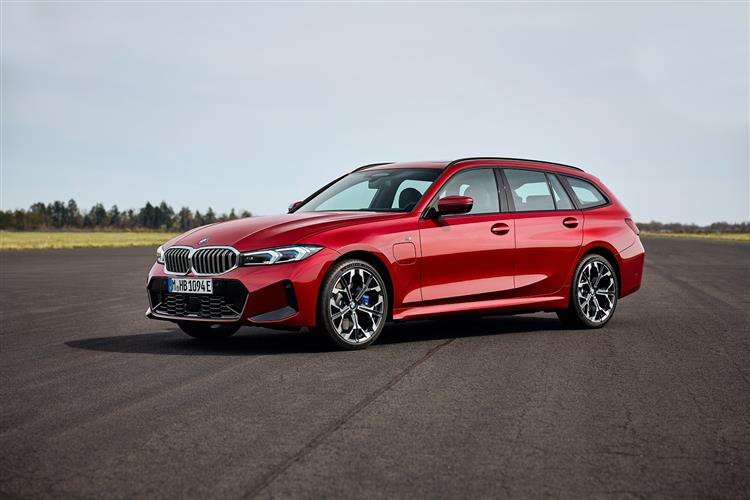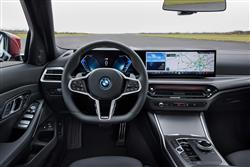How will you view?
This is a sample, and will stop after 30 seconds.
TOUR OPERATOR (some text hidden) SECTIONED_new_bmw3seriestouring_2021
By Jonathan Crouch
The seventh generation version of BMW's 3 Series Touring gets a further package of useful updates. Jonathan Crouch takes a look.
Ten Second Reviewword count: 130
The improved version of the seventh generation BMW's 3 Series Touring holds no great surprises to those who understand the narrative of this model. It's not the most accomplished load lugger in its class but it's the best drive and offers the most efficiency. That'll be enough to clinch the deal for most who just hanker after a 3 Series with a bit more versatility. In this further enhanced form, it's smarter and gets an even more sophisticated cabin. Diesel's been dropped but the 330e PHEV version gets a much larger battery. And there's a big step forward in media connectivity. All the things you'd expect from a facelift really. Something else you'd expect from this model is rear wheel drive handling purity. It doesn't disappoint in that regard either.
Backgroundword count: 195
Conventional wisdom dictates that estate cars are designed for people who can't fit all the paraphernalia of modern life inside a conventional saloon or hatchback model. You'd certainly imagine that an estate would require a lot more space than the saloon on which it is based in order to justify its own existence but, particularly in the compact executive sector where BMW's 3 Series Touring competes, it isn't always that straightforward. It might be a surprise for some people to learn that many mid-sized executive estate cars are only fractionally roomier than their saloon equivalents - and some even have less space out back. Estate buyers in this sector are typically also asked to pay around £2,000 more for the privilege over the cost of the alternative saloon. That's extra money for extra space. How much extra space in this case? With the rear seats in place, just 20-litres over the saloon. You don't, in other words, buy this car for its luggage cramming talents. You buy it because you want the capability in hand and also because it's a little more 'lifestyle' and a little less 'field sales' than the standard 3 Series saloon.
Driving Experienceword count: 358
Unlike Audi and Mercedes, BMW doesn't see diesels as part of its electrifed future. it does however, continue to put a lot of store in its PHEV technology, which is why the major changes with this second update to the G21-era Touring design are with the 330e Plug-in Hybrid. This now gets a bigger 19.5kWh battery, which allows for a considerably longer 61 mile electric driving range. That means a suburban driver really could start to use their 330e Touring much like an EV. The combined output of this powertrain's 2.0-litre petrol engine and electric motor now stands at 292hp (8hp more than before), facilitating a 62mph sprint time of 6.0s en route to 142mph. Otherwise, the only remaining mainstream engine you can have is the 184hp 2.0-litre petrol unit of the 320i which, like the 330e, is offered only in rear-driven form and makes 62mph in 7.6s en route to 142mph. If you want something more powerful, there's the M340i xDrive, which has AWD and a 3.0-litre petrol six cylinder unit developing 374hp and, thanks to 500Nm of torque, is good for 62mph in 4.6s on the way to a top speed limited to 155mph. The road-burning M3 Competition Touring still tops the range of course, now with mandatory xDrive and a 530hp version of the usual 3.0-litre twin turbo six cylinder engine. With mainstream models, BMW's tweaked the chassis to imptrove comfort. And has added stiffer mounting points for the rear dampers, faster, more responsive steering and an upgrade for the optional adaptive dampers. Otherwise, much is familiar here. All 3 Series models get the near perfect 50:50 weight distribution that has defined this model line to date: this updated seventh generation model doesn't deviate too far from that script. Still notable are the standard 'lift-related' dampers. These clever shock absorbers incorporate structures that provide extra damping at the extremes of wheel travel, allowing quite a firm sporting set-up to be adopted, but also one able to deliver a fluent ride over tarmac imperfections. Thanks to that, this car's able to combine a set-up for Silverstone with something that works equally well on the North Circular.
To see the full road test text contact us on 0330 0020 227
Pictures (high res disabled)

.jpg)
|
.jpg)
|
.jpg)
| |||
.jpg)
|
.jpg)
|
.jpg)
| |||
.jpg)
|
.jpg)
|

|
Statistics (subset of data only)
Min |
Max |
|
Price: |
£43,840.00 (At 2 Apr 2025) |
£126,185.00 (At 2 Apr 2025) |
CO2 (g/km): |
233 (M3) |
|
Max Speed (mph): |
142 (320i) |
155 |
0-62 mph (s): |
7.6 (320i) |
3.6 (M3) |
Electric WLTP-Rated Driving Range (miles): |
61 |
|
Combined Mpg: |
27.4 (M3) |
313.9 (330e) |
Length (mm): |
4633 |
|
Width (mm): |
2031 |
|
Height (mm): |
1416 |
1434 |
... and 4 other stats available | ||
Scoring (subset of scores)
Category: Luxury Saloons and Estates
| Performance | |
| Handling | |
| Comfort | |
| Space | |
| Styling, Build, Value, Equipment, Depreciation, Handling, Insurance and Total scores are available with our full data feed. | |



